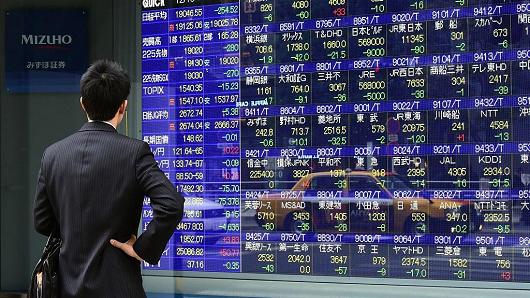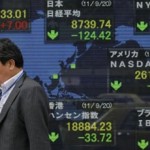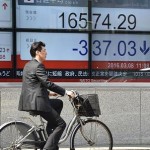Asia markets broadly lower as risk-off sentiment settles in

Asia markets were broadly lower on Friday, after U.S. equities sold off overnight amid renewed concerns over global growth and the effectiveness of central bank policy.
Australia’s ASX 200 retraced some of the early losses to trade down 0.4 percent, as the heavily-weighted financial sub-index retraced losses of over 1.4 percent to trade down 0.42 percent. The country’s so-called Big Four banks – ANZ, Commonwealth Bank of Australia, NAB andWestpac – traded mixed, between up 0.17 percent and down 0.73 percent.
Japan’s benchmark Nikkei 225 was off 0.46 percent, after selling off nearly 1.3 percent in early trade; across the Korean Strait, the Kospi fell 0.69 percent. Hong Kong’s Hang Seng index lost 0.88 percent in early trade.
Chinese mainland markets also fell, with the Shanghai composite lower by 0.56 percent and the Shenzhen composite losing 0.74 percent as of 10:03 a.m. HK/SIN time.
“It’s been a distinctly ‘risk-off’ night,” said Ray Attrill, global co-head of foreign exchange strategy at the National Australia Bank, in a morning note, adding financial stocks took a beating overnight.
“Increased dissolution about what central policies will continue to do to financial sector profitability may be a factor here,” he said, adding, “as too investors bracing for the Q1 earnings season (that kicks off in earnest on Monday) and where the banks are anticipated to reveal a truly rotten start to the year.”
Major stock indexes in the U.S. closed down, with the Dow Jones industrial average off 0.98 percent, the S&P 500 finishing down 1.2 percent and the Nasdaq composite 1.47 percent lower.
In the currency market, the dollar index, which measures the U.S. dollar against a basket of currencies, advanced 0.15 percent to 94.61 as of 10:05 a.m. HK/SIN time.
Down Under, the Australian dollar traded at $0.7527 after trading as high as $0.7637 on Thursday.
The Chinese yuan was weaker against the dollar Friday morning, with the dollar/yuan pair traded up 0.25 percent at 6.4761. Before market open, the People’s Bank of China set the yuan mid-point at 6.4733 to the dollar. China’s central bank lets the yuan spot rate rise or fall a maximum of 2 percent against the dollar relative to the official fixing rate.
Data released on Thursday showed China’s foreign exchange reserves rose slightly in March to $3.21 trillion, compared to a Reuters poll forecast of a drop to $3.18 trillion and a print of $3.20 trillion in February. This was the first monthly increase since November, but reserves are still down sharply from their peak of $3.99 trillion in June 2014, said Reuters.
Cynthia Kalasopatan from Mizuho Bank said in a note several factors could have led to the uptick in China’s foreign exchange reserves, including “less pronounced capital outflows,” “valuation effects” and “reduction in repayment of external loss.”
But Kalasopatan cautioned, “It is important to note that despite a rise in FX reserves, capital outflows may still be taking place; valuation effects may have outweighed capital outflow effect.”
She added recent yuan stability suggests that “the Chinese authorities are focused in containing volatility.”
Alarm bells on yen?
But the focus is on the Japanese yen, which remained at its strongest level against the greenback since October 2014. The dollar/yen pair fell as low as 107.67 overnight, before recovering to 108.77 in the morning local time.
Kathy Lien, managing director of foreign exchange strategy at BK Asset Management, said in a note that the yen’s appreciation spelled big trouble for Japan’s businesses and economy.
“Alarms should be ringing at the Ministry of Finance and Bank of Japan,” she said. “However, everything that we have heard from the Japanese government so far suggests that they are not ready to intervene in the foreign exchange market to lower the value of their currency.”
Lien added that it was becoming clear that the Japanese central bank”could allow dollar/yen to fall to 105 and maybe even 100 before taking action.”
Major Japanese exporters traded mixed mid-morning, taking some cues from the yen’s slight weakness to the dollar Friday morning. A stronger yen is a negative for exporters as it affects their overseas profits when converted into local currency.
Shares of Toyota down 1.09 percent, Honda off 0.37 percent and Sonylosing 1.2 percent, retracing some of their earlier losses. Nissan shares traded up 0.14 percent.
In corporate news, shares of the heavily-weighted Japanese retailerFast Retailing slumped 10.07 percent, after the company trimmed its outlook on Thursday. Reuters reported that Fast Retailing’s quarterly profits were hurt by price cuts at its clothing chain Uniqlo.
In its fiscal second quarter through February, Fast Retailing reported an operating profit of 23.4 billion yen ($215 million), down from 58.7 billion in the same period a year ago, and said it expected operating profit for the full year through end-August to be at 120 billion yen compared to a previous outlook of 180 billion yen in January, said Reuters.
Oil prices advanced during Asian hours, with U.S. crude futures trading up 1.72 percent at $37.9 a barrel, while Brent futures added 1.22 percent to $39.9 as of 10:10 a.m. HK/SIN time.
Overnight oil prices retreated after data showed higher weekly inventories at the U.S. crude storage base. Reuters said market intelligence firm Genscape reported a build of 255,804 barrels at the Cushing, Oklahoma, delivery hub for U.S. crude futures in the week to Tuesday.
Energy plays in Asia were mostly lower, with shares of Santos selling off 0.92 percent, Inpex off 1.62 percent and mainland China’s Sinopecoff 3.7 percent. Oil Search, on the other hand, added 0.3 percent.
Source: CNBC




























